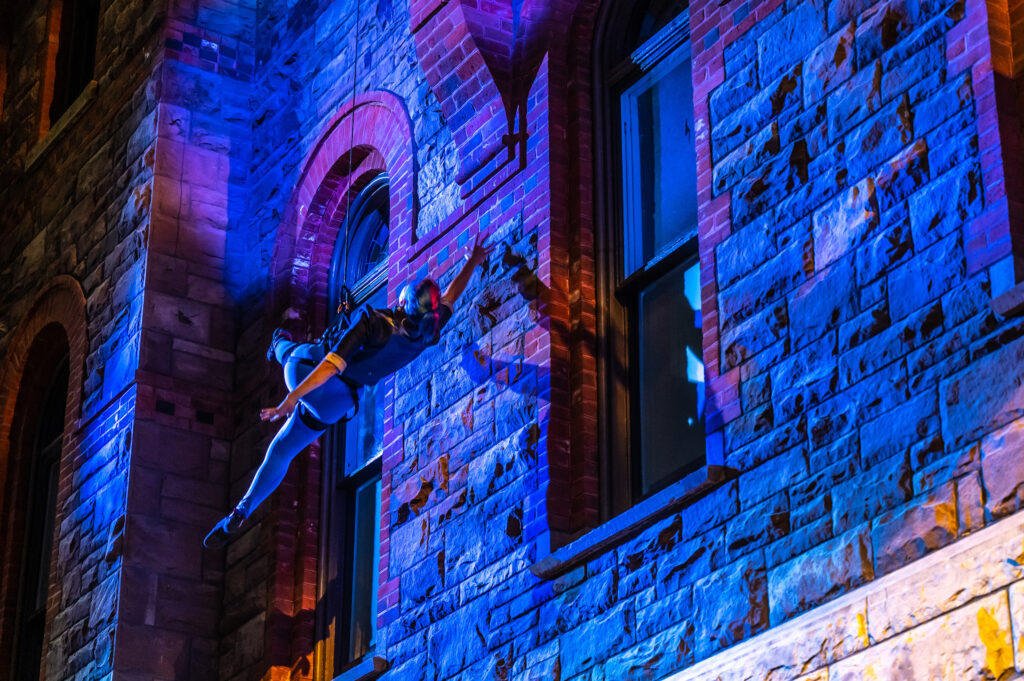All the celebrated trademarks are there. The woolen cap. The fingerless gloves. The scruffy overcoat. The quirky collapsible chair made by his father that lowered him to eye level with the keyboard. The fitful conducting in mid-air. The incessant humming. The gleam in the eyes. The slump in the shoulders.
And something else, as well. Something equally substantial. Something undefined.
A palpable sense of aloneness. A battered world weariness. A resigning of self to history.
Movingly evoking the deathless spirit of piano legend, Glenn Gould, baritone Roger Honeywell, partnered by singer/actor/aerialist Lauren Pearl in a parallel role, give forceful form and impetus to a soaring operatic discourse on creativity and expression, challenge and aspiration.
Gould’s Wall, Tapestry Opera’s latest sold-out offering, libretto by Liza Balkan, music composed by Brian Current, adamantly resists simple analysis and/or description. A genre-bending fusion of music theatre, 3D opera-ballet and performance art, the unremittingly intense 60-minute rush of dramatic experience sweeps us up in a surge of emotion, depositing us in a vertiginous place of hard-won catharsis.
Nestled between the antique sandstone and gleaming contemporary glass of the Royal Conservatory of Music’s inner Atrium we watch, necks craned, wide-eyed and enraptured, as director Philip Akin, aided by assistant directors Sheree Spencer and Michael Hidetoshi Mori, guides an extraordinarily gifted cast through the loose knit web of vignettes that serves as a highly abstract source of story.
A ferociously determined young artist, known only to us as Louise, is confronted, quite literally, by a towering wall of massively challenging proportions in her quest to realize her creative goals. Gould appears, an almost mystical presence, to support her, a source of abiding empathy and understanding. Figures from his past assume haunted form, characters appearing and disappearing, dizzily peering downwards from open windows high above. Memories are related. Thoughts are shared.
The degree of historical accuracy implicit in scenes related to Gould’s life, personal and professional both, is, by and large, as meticulous as it is unexpected.
Alberto Guerrero, Gould’s one and only formal teacher, something of an eccentric, free-spirit at the Toronto Conservatory (later incorporated as the RCM), is summoned, albeit anonymously, famously exhorting his teenage charge to visualize pulling down on the piano keys from below rather than exerting blunt pressure from above.
Veiled reference is made to a back injury sustained by Gould as a child which some biographers — Otto Friedrich (Glenn Gould: A Life and Variations) and Kevin Bazzana (Wondrous Strange: The Life and Art of Glenn Gould) among them — have suggested may account for the worrisome bouts of mysterious musculoskeletal pain that plagued Gould in middle age precipitating years of rampant prescription drug abuse.
A controversial appearance with Leonard Bernstein and the New York Philharmonic forms the basis of a searingly satirical monologue, related by an insufferable party guest, referencing Gould’s defiantly languid tempi during his performance of the Brahms D-Minor Piano Concerto at Carnegie Hall in 1962.
Resonant atmosphere and vibrant biographical detail aside, when all is said and done however, accuracy of reportage and authentic backstory are essentially secondary here. Gould’s Wall is less concerned with the facts of Gould, more with the idea of the man. Less with the identity of The Artist, more with her ethos. It is the striving that matters, the quest for transcendency.
After expending herculean effort, Louise summits The Wall. Gould has arrived there before her. Before he had learned to loathe competition and applause. Before he had found new exploits to challenge him. Summoning the courage to climb down took time.
In April, 1964, at the height of his powers, Glenn Gould, arguably the most exciting piano virtuoso of the mid-century, walked off a recital stage in Los Angeles never to return to the world of in-person performance. He was 31. The remainder of his musical career would be spent recording an eclectic assortment of brilliantly reconsidered classical and modernist works. Mass media would come to fascinate him, radio in particular. He would die a broadcasting pioneer.
The effectiveness of the wall as metaphor lies in the flexibility of the conceit. Story arcs twist and twine around one another as they climb towards the evening’s close.
Yet, for all its taut theatrical unity, Gould’s Wall is nevertheless the product of a significant degree of planned actorly opposition. Honeywell, a master of stillness and quietude commanding the lower reaches of the set. Pearl, all action and aerial arabesques, spinning and twirling two and three stories above. Moments of physical proximity seldom factor into director Akin’s staging but when they occur the results are powerful. Huddled together in a rare ground-hugging scene, the two newfound soulmates share their deepest fears and regrets. I had the dream again,/Always the same/Niagara Falls, shivers Pearl’s Louise, her voice shimmering with apprehension. Here’s a nightmare, Honeywell’s Gould rejoins sadly. I was in love with a beautiful girl/I asked her to marry me, but she turned me down. The moment lingers long in the mind.
Solos and ensembles, singing greatly impresses, top to bottom on the wall.
Appearing as Gould’s teacher, baritone Justin Welsh scores the perfect notes of prickliness and patience underscored with more than a hint of frenzied obsession. Mezzo-soprano Andrea Ludwig performs as Gould’s mother in a difficult, painfully complex role, domineering and overprotective, a deftly assumed hint of tremulousness betraying her character’s half-hidden fear of the future. Tenor Keith Klassen is the hugely annoying aforementioned party guest. Soprano Caitlin Wood is a touching letter-writing fan. 13-year old singer-actor Alice Malakhov contributes a fine, profoundly poignant performance as a young girl seeking Gould’s reassurance and assistance with a taxing piano piece.
An outstanding 18-player classical ensemble courtesy the Royal Conservatory of Music’s Taylor Academy for gifted students partners off-stage, dispatching great swaths of Schoenbergian 12-tone interspersed with more than a few contrapuntal hints of Bach segueing to lush Romanticism with great vitality and finesse. Jennifer Tung conducts, leading with immense clarity and insight.
Visionary. Convention-defying. Transformative. Gould’s Wall is a startling reminder of what opera can and must always be.
Let’s confuse all aural expectations/and climb no straight line.


